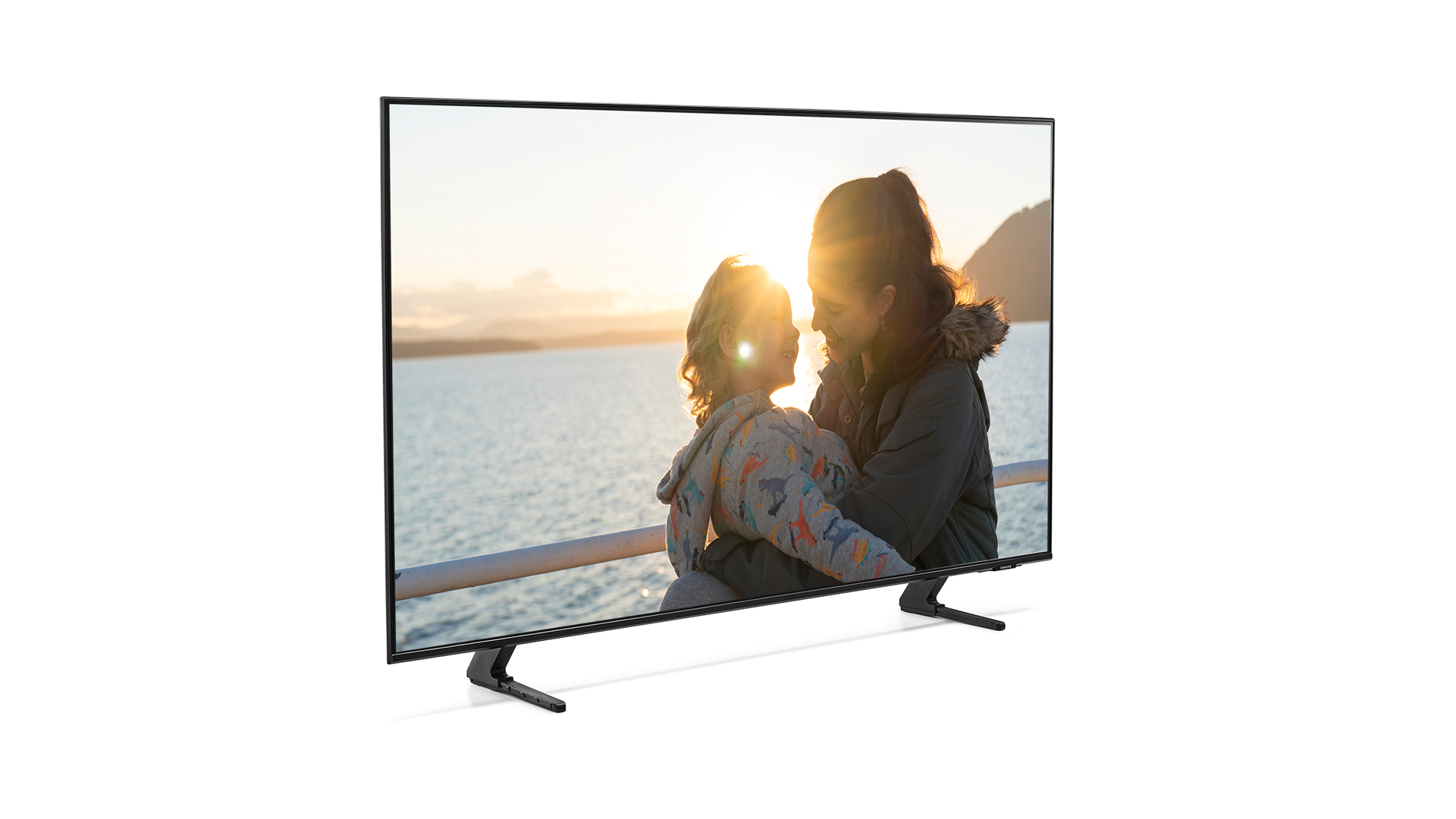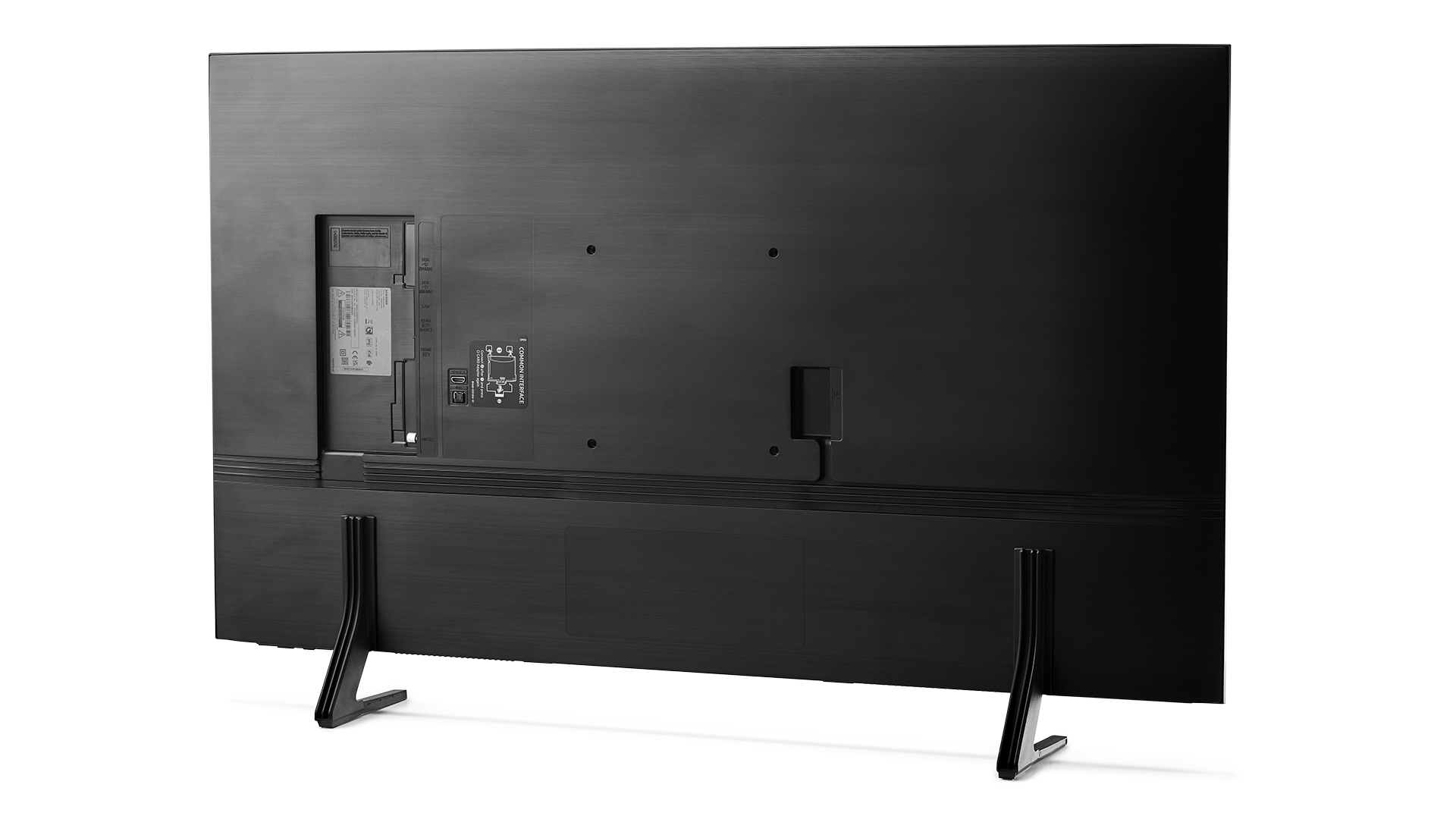What Hi-Fi? Verdict
While we’d very happily own a UE50AU9000, especially for gaming, it’s not quite impressive enough to steamroller some cheaper competition
Pros
- +
Bright and refined image
- +
Perfect design for wall-mounting
- +
Terrific for gaming
Cons
- -
Slightly shallow black levels
- -
Soft 4K delivery
- -
Stiff competition
Why you can trust What Hi-Fi?
We Brits, it seems, just love a good mid-range LCD TV. For whereas the US and Australia only get a single series of Samsung’s sub-QLED ‘Crystal’ range, here in the UK we get no less than three Crystal ranges: AU7100, AU8000, and the premium AU9000 series represented here by the 50-inch UE50AU9000.
As you’d hope, the AU9000 has the design prowess and extra features required to start justifying its supposed cream of the Crystal 4K crop status. Whether or not you think its prowess extends to the performance, though, probably depends on what you most use your TV for.
Price
At £599, the UE50AU9000 sits at the upper end of what might reasonably be called a ‘budget’ TV.
You can, after all, get Samsung’s own entry-level Crystal LED model, the 43-inch UE43AU7100, for just £449, while Hisense even does a 50-inch Roku TV, the R50A7200UK, for a mere £399.
This might help explain why Samsung hasn’t released the AU9000 range in the notoriously hard-nosed US and Australian markets. As we’ll see, though, the UE50AU9000 does potentially have what it takes to tempt punters into a bigger spend than they might ideally have been contemplating. In fact, if all of its elements come together as we hope they will, it might actually end up looking like a bargain.
Design

The UE50AU9000’s so-called AirSlim design is so skinny you could be forgiven for thinking it must be using an OLED panel rather than an LCD one. Inevitably given its £599 price this is not actually the case – but it’s certainly fair to say that it’s a remarkable looking thing by sub-£600 LCD TV standards.
Its lack of heft marries up nicely with a super-narrow bezel, while the whole remarkably slight affair slots and locks (no screws required!) onto a pair of tastefully understated feet.
The latest hi-fi, home cinema and tech news, reviews, buying advice and deals, direct to your inbox.
The bodywork is more solidly built than many rivals in its class, and it’s so slim from every angle that you barely notice its physical form at all once it’s switched on and you’re immersed in its pictures.
Tucked inside the AU9000’s box are two remote controls. Both are easy to get to grips with, but once initial installation is done we suspect most people will gravitate towards the impressively sleek and ergonomic little ‘smart’ handset.
Features

The AU9000 joins the other AU models for 2021 in being built around an edge-lit native 4K VA panel. It also joins its AU8000 sibling in sporting Samsung’s wide-gamut Dynamic Crystal colour technology, which is reckoned to deliver 64 times more shades of colour than ‘conventional’ 4K TVs (whatever those might be).
The same Crystal 4K processor that’s found in the AU7100 and AU8000 models is on hand to drive the Dynamic Crystal panel, and the AU9000 joins the other AU series in supporting the HDR10, HLG and HDR10+ HDR formats - but also in not supporting the Dolby Vision format.
It carries the same Tizen-based Eden smart system as the cheaper AU series too, complete with its compact but effective and easily customisable onscreen menu system and comprehensive (except for the lack of Freeview Play) app support.

Screen type LCD w/ edge LED backlight
Resolution 4K
Operating system Eden (Tizen)
HDR formats HDR10, HDR10+, HLG
HDMI x3
4K@120Hz No
VRR Yes
ALLM Yes
ARC/eARC eARC
Optical out Yes
Dimensions w/o stand (hwd) 43 x 112 x 2.6cm
Where the AU9000 puts clear blue water between itself and its cheaper siblings, though, is with its gaming features. For, unlike the other AU ranges, the AU9000’s three HDMIs can support both VRR (variable refresh rate) and 120Hz signals. This instantly makes the UE50AU9000 a much more compelling option as a monitor for a PS5, Xbox Series X or a PC with a new high-end Nvidia or AMD graphics card – even though the 120Hz support can only be sustained at 1080p resolutions rather than 4K.
The gaming features don’t stop there, either. There’s also support for ALLM (Auto Low Latency Mode) and input lag with Game mode activated is a minuscule 9.2ms, and you can call up a handy Game Bar display that shows you at a glance what graphics features a game is using.
What’s more, in keeping with Samsung’s Neo QLED TVs, the 50AU9000 can support playback in 32:9 ratio from PC games that support this super-wide format.
One final area where the AU9000 potentially goes a long way towards justifying its higher price is its sound. It’s the only model of the AU range to benefit from Samsung’s Object Tracking Sound (OTS) technology, where a combination of carefully placed speakers and nifty audio processing creates the feeling that specific sound effects are coming from the exact place on (or off) the screen that they’re supposed to be coming from.
To be clear, the UE50AU9000 only gets a ‘Lite’ version of OTS, created from just two 10W speakers. There isn’t an array of speakers ranged all around the screen as there is with Samsung’s more high-end Neo QLED TVs. Hopefully, though, we’ll still hear some benefit from it.
Picture

It’s good to see an edge LED TV of this size kicking off its picture quality argument with a pretty respectable contrast performance. Dark scenes enjoy more depth and more backlight uniformity than we usually see with sub-£600 LCD TVs, despite light scenes also looking eye-catchingly bright.
The set also achieves a satisfying compromise between black levels and brightness with shots that contain a mix of bright and dark elements, and shadow detailing in dark scenes holds up well.
You can spot a few quite large areas of backlight clouding over dark scenes if your room is pretty much completely blacked out, but these are so faint that they largely disappear if you retain even a hint of ambient lighting.
The UE50AU9000 delivers some excellent colour work, too. Particularly vibrant imagery, such as Pennywise’s portentous red balloons in the 4K Blu-ray of It, enjoys a combination of vibrancy and subtlety that you’d normally only expect to see on a much more expensive TV. At the same time, the calmer, more subtly differentiated tones associated with meadows, leaves, sand dunes and so on are presented with a deftness of touch that really boosts the image’s sense of realism and depth of field.

Colours look unusually well balanced, too, meaning that you don’t find your eye being drawn to the ‘wrong’ parts of an image by any rogue over-aggressive or under-finessed tones.
The qualities that make the UE50AU9000 a good TV also make it an excellent gaming display. Its brightness and rich but controlled colours play beautifully with the spectacular 4K HDR graphics capabilities of the latest gaming machines, while the support for higher and variable refresh rates joins forces with the exceptionally low input lag to contribute to a fantastically immediate and immersive experience.
The UE50AU9000 even supports slightly – though we stress slightly – wider viewing angles than most LCD TVs, which could be handy if you have a few mates over for gaming nights.
While it’s hard to knock the UE50AU9000’s gaming performance, though, it does suffer a few little wobbles with video. For starters, its 4K pictures don’t look as sharp as we’ve come to expect from Samsung TVs – or as those we’ve seen on a number of similarly affordable or cheaper 4K TVs. This is made to look even more strange by the way the TV upscales HD sources with levels of sharpness and detail that leave most rival affordable 4K TVs in the dust.
There’s slight resolution loss, too, during camera pans even after you’ve optimised the TV’s motion processing (by choosing Custom in the Picture Clarity menu and setting judder reduction to level four).
Next, while black levels are good by edge LED standards, there’s typically still a slight blue-grey tone hanging over dark scenes that isn’t there on one or two cheaper sets that have crossed our test benches in recent times.
Finally, while the UE50AU9000 opts for a generally quite bright presentation and suffers with scarcely any subtle tone clipping in peak light areas of HDR pictures, it doesn’t deliver the same sense of HDR light range that some rivals do. Especially when it comes to the punch delivered by the brightest highlights.
Sound

The AU9000 makes surprisingly good use of its OTS sound technology considering it’s only got two speakers to work with.
The soundstage is cast way beyond the TV’s sides, for instance, creating an expansive, immersive and detailed audio environment. Sounds that are supposed to remain attached to the onscreen action, though, aren’t just kept there, but are positioned with accuracy. So, for instance, if people on the left and right of the screen are having a conversation, you will clearly hear the voices of each speaker coming from the correct side of the screen.
The only pity is that a lack of bass and raw power whenever the UE50AU9000 is asked to apply its OTS cleverness to a dense action movie scene can sometimes make the set’s large, accurately staged sound suddenly feel thin and fragile.
Verdict
The bad news for the Samsung UE50AU9000 is that it shows just enough weakness when it comes to its handling of very dark scenes and native 4K sharpness to open itself up to challenge by some of the cheaper stars of the budget TV firmament.
The good news is that it’s hard to imagine anyone who ends up with one being unhappy about any aspect of its performance. It doesn’t do much wrong, and gets plenty right. Especially if you’re into gaming.
SCORES
- Picture 4
- Sound 4
- Features 5
MORE:
Read our review of the Samsung UE43AU7100
Read our thoughts on the Hisense Roku 50A7200GTUK
Check out our TCL 55RP620K review
Read our round-up of the best budget 4K TVs
What Hi-Fi?, founded in 1976, is the world's leading independent guide to buying and owning hi-fi and home entertainment products. Our comprehensive tests help you buy the very best for your money, with our advice sections giving you step-by-step information on how to get even more from your music and movies. Everything is tested by our dedicated team of in-house reviewers in our custom-built test rooms in London, Reading and Bath. Our coveted five-star rating and Awards are recognised all over the world as the ultimate seal of approval, so you can buy with absolute confidence.


